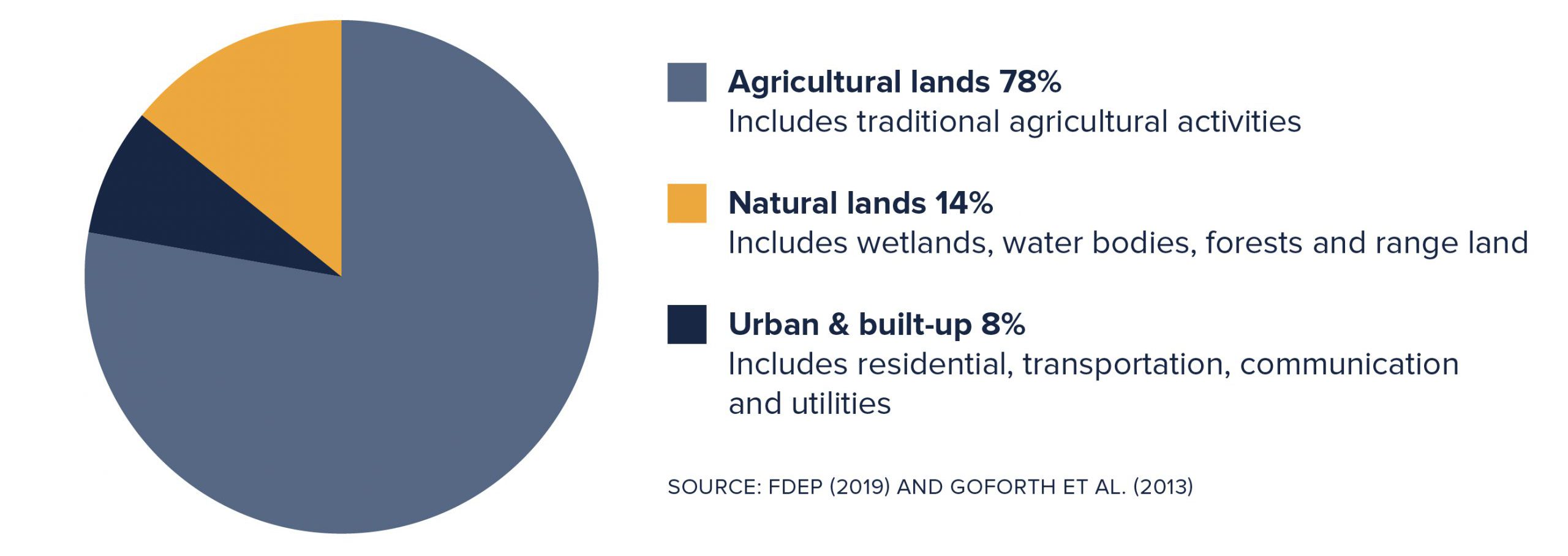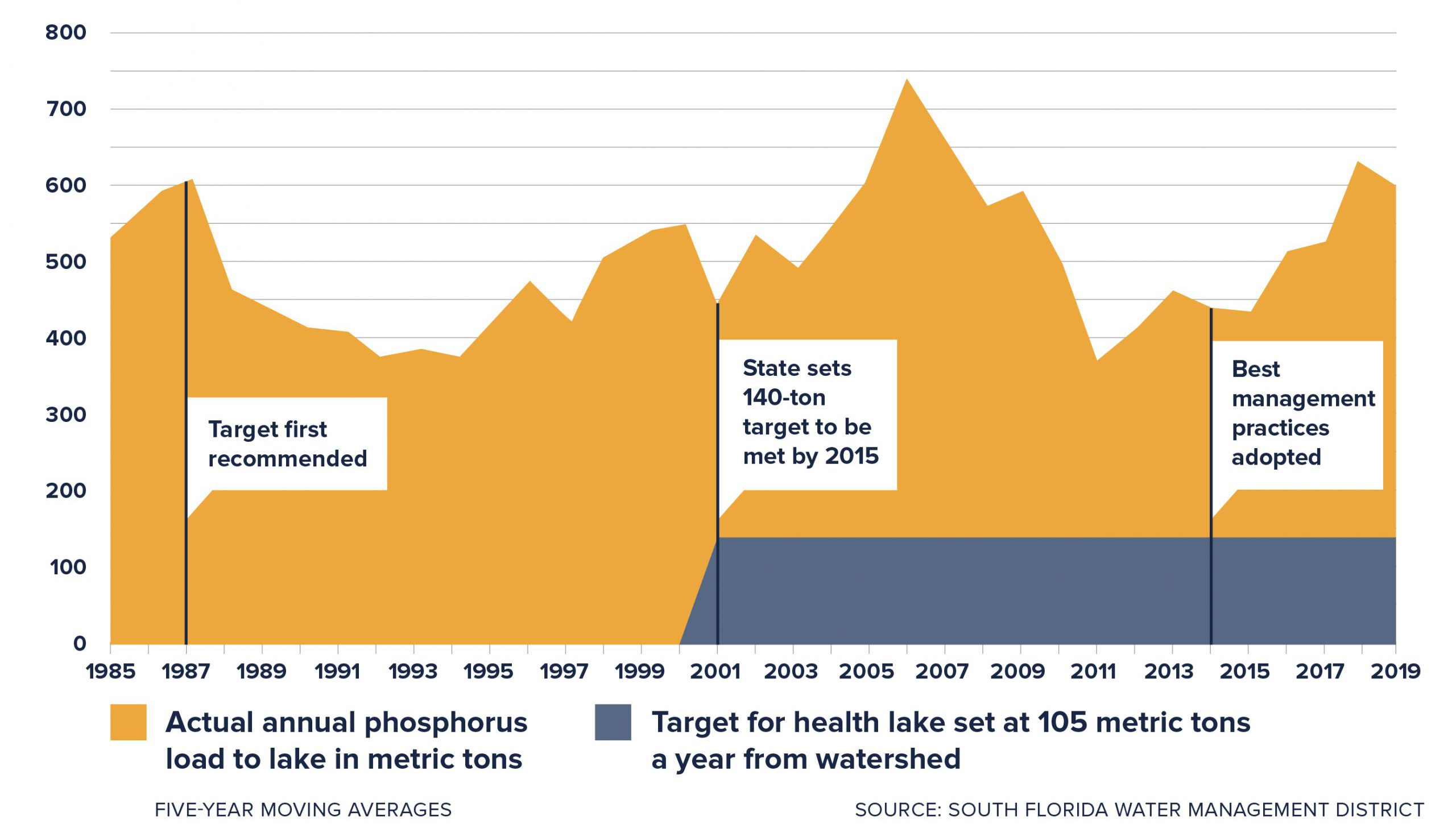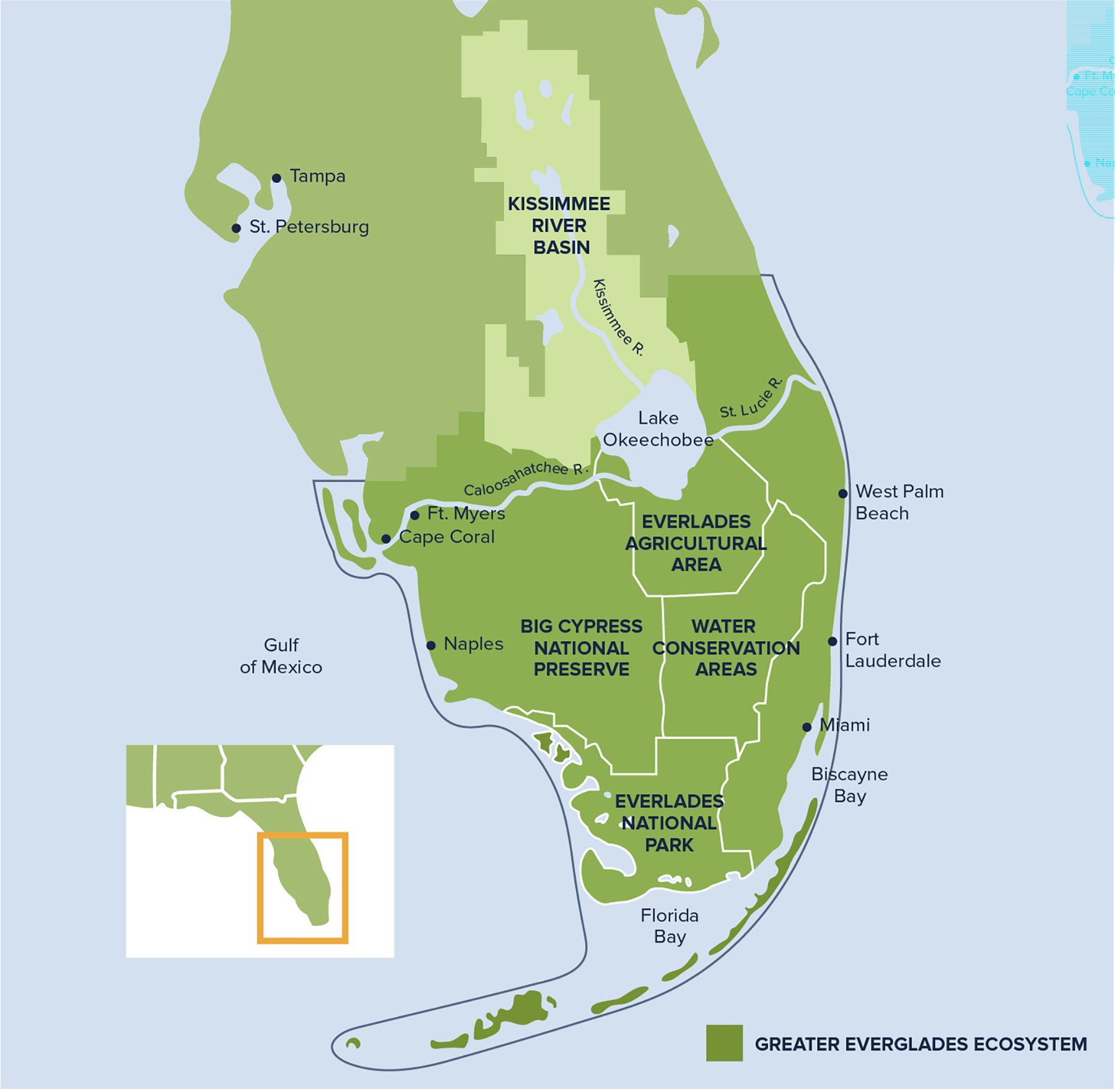Florida has struggled for almost two decades to control the blue-green algae that periodically carpets Lake Okeechobee and threatens tourism on the coast. The blooms in the state’s largest freshwater lake are stimulated by phosphorus, a key ingredient in the fertilizer used on nearby ranches and farms.
The state has passed laws and spent hundreds of millions of dollars on water treatment projects to reduce the phosphorus flowing into the lake. But it continues unabated, according to a review of state water-monitoring data by Weather.com and the Investigative Reporting Workshop.
The amount of phosphorus entering Lake Okeechobee today is roughly the same as it was in 2001, when the state ordered what would have amounted to a 70% reduction by 2015. Analyses of state data show agricultural runoff is the source of three-quarters of it.
In March, the legislature tackled the algae problem again when it passed the Clean Waterways Act of 2020.
But the new law, like the 2001 law, does little to address agricultural runoff.
It doesn’t require growers to monitor or reduce the phosphorus running off their land, even though a court-ordered regulatory system south of the lake has been a big success. Instead, the new law continues what is effectively a voluntary state program — one so forgiving that no rancher or farmer has been sanctioned for water-quality violations.
Where the phosphorus is coming from

Florida’s phosphorus problem is so acute that it has created a divide between the agriculture industry in the center of the state and tourism hubs on the Atlantic Ocean and Gulf of Mexico. Phosphorus from Lake Okeechobee reaches the coasts through rivers and man-made canals, nourishing a smelly, guacamole-like algal goop that drives away tourists and can be toxic to humans. Coastal residents increasingly blame the agriculture industry for the mess. Farmers and ranchers insist they’re not to blame and argue that costly water regulations would doom their way of life.
Reaching a solution will be politically challenging. Many experts say tougher monitoring and regulation of agricultural runoff is necessary, but the agriculture industry, with its great political clout, continues to resist regulation.
“Solving this problem requires proactive efforts to monitor, to regulate and to enforce,” said Keith Rizzardi of St. Thomas University School of Law in Miami Gardens, Florida. Rizzardi also served as an attorney for the South Florida Water Management District and the U.S. Department of Justice Division of Environmental and Natural Resources.
But conservation biologist and ecologist Hilary Swain warns that regulations, if not carefully thought out, could force ranchers off the land and encourage more intensive forms of farming or development.
“None of this is cheap,” said Swain, director of Archbold Research Station, near Lake Okeechobee. “None of it is easy, and all of it’s going to, unfortunately, take quite a long time. But all of it is worth doing and all of it’s worth doing now because our problems are only going to get worse. We’re only digging ourselves a deeper hole down the road if we don’t address this.”
New push to address the problem
One of the most vexing challenges posed by phosphorus is that it forms a strong chemical bond with soil and only a small portion is released at any given time, usually with heavy rainfall. It could be decades or even centuries before all the phosphorus currently in the agricultural basin washes into Lake Okeechobee, in the interior of the lower part of the Florida peninsula.
The bottom of the lake, which was sandy for thousands of years, already is blanketed with millions of tons of black muck containing an estimated 50,000 metric tons of phosphorus. Nobody knows how to remove or neutralize it.
People still flock to the lake to fish, but the tall grass and abundant waterfowl belie the dark transformation taking place beneath its surface. Algal blooms kill aquatic plants by blocking sunlight. Their decay then depletes oxygen in the water, which kills aquatic animals. The lake’s once-clear water is almost opaque.
Rising temperatures associated with climate change will likely exacerbate the problem because algae thrive in heat. Two weather stations near the lake registered eight of their 10 warmest summers in the past decade. Annual temperatures have risen 2.2˚F since 1970 at one station and 3.3˚F since 1953 at the other, according to Weather.com meteorologist Jonathan Erdman.
A 2016 algal bloom covered 5% of the lake’s surface. Two years later, 90% of the surface was covered, forcing then-Gov. Rick Scott to declare a state of emergency in seven hard-hit counties.
Former U.S. House Rep. Gov. Ron DeSantis, who replaced Scott as governor last year, made dealing with the algae crisis a key focus of his gubernatorial campaign.
One of his first acts was to fire the entire board of the South Florida Water Management District, which is charged with managing and protecting the water of 16 South Florida counties. Over the years, it had developed a reputation for prioritizing agricultural interests. That changed with DeSantis’ new appointments, some of whom had been clean-water activists.
DeSantis also formed two task forces to recommend legislation. States are responsible for dealing with farm runoff because the federal Clean Water Act exempts agriculture from regulations that apply to commercial, industrial and residential property.
But neither the task force recommendations nor the new law passed by the Florida legislature set a deadline for reducing phosphorus going into the lake. And there is still no system in place to monitor or enforce pollution limits on farm runoff.
No progress in reducing phosphorus into Lake Okeechobee
The load remains three to four times what it should be.

The agriculture industry has long and vociferously opposed efforts to establish a regulatory system north of the lake like the one that resulted from a court order south of it.
In 2011, the South Florida Water Management District hired Gary Goforth — a water resources engineer who helped create the plan for south of the lake — to help design a regulatory similar system for the rest of the agricultural basin, including the ranchlands in the north. It was based on the permitting system used in the south, but Goforth said it allowed for differences in soil and terrain.
In 2013, the water district seemed ready to roll out the program, Goforth said. He went to Tallahassee, the capital, to brief state officials. Rick Scott, a conservative Republican known for his antipathy for environmental regulations, had been elected governor that year.
“We gave the presentation and the next thing I knew, the whole program was shut down,” Goforth recalled. He said he never got an explanation.
Ranchers and their supporters in Tallahassee argued that the regulatory structure south of the lake wouldn’t work in the north, because the hydrology, topography and soil are too different.
[Story and video: What the ranchers say]
Farmland in the south is densely planted and highly engineered with pipes and pumps. The ranchlands of the north often consist of wide-open spaces that flood during rainy seasons and would be more difficult to monitor.
“On this property, water comes off of Highway 98, comes onto my property, goes into the neighbor’s property and then comes back on my property and then goes out,” said Matt Pearce, head of the Okeechobee-based Pearce Cattle Company. “So, how do you measure that?”
Ranchers also argued they couldn’t pay a special per-acre tax like one farmers in the south pay as part of that regulatory program, because the rate of return per acre for ranching is lower than for farming.
The new law reflects those concerns and doesn’t include the type of regulatory system that worked south of the lake. The Florida Cattlemen’s Association and other agriculture groups supported the final version of the law.
A few days after the law was passed, a provision was slipped into an unrelated bill that made future regulatory efforts less likely. It strips the South Florida Water Management District, which designed and runs the successful program south of the lake — of authority to create new regulations affecting agriculture, a power it had held since 1989. Now, all agricultural regulations must come from the Florida Department of Agriculture and Consumer Affairs, which has been regulating the ranchers without results for years through its Best Management Practices program.
Weather.com and the Investigative Reporting Workshop asked Chris Pettit, the chief water official for the Agriculture Department, what results he could point to from the Best Management Practices program in the basin that drains into Lake Okeechobee. “We are actively undertaking research to demonstrate or identify the benefits that have resulted in the basin,” he replied.
In the months leading up to the law’s passage, “Alligator Ron” Bergeron, a member of the water board and a rancher himself, repeatedly called for “reasonable” regulations to stop pollution coming off agricultural property.
“Whatever we’re doing isn’t working,” he said at a board meeting. “We’re talking about billions and billions of gallons of state waters that are being polluted. If we don’t have reasonable regulations on what’s entering state waters, you cannot build enough projects to clean this up.”
What is at stake, he said, is the health and economy of 8 million people, trillions of dollars in real estate, the Everglades and the Florida aquifer.
After the Clean Waterways Act passed without restrictions on agricultural discharges, Bergeron declined to talk publicly.
Stewards of the land
While Florida is better known for its oranges and sugarcane, about half its agricultural land is devoted to cattle ranching. Last year, the state had close to a million beef cows and more than 100,000 milk cows, ranking it 13th in the nation.
The heart of the cattle industry lies in the Kissimmee River basin, which serves as the headwaters of the Everglades. The basin stretches from just south of Orlando down to Lake Okeechobee, about 95 miles. The Kissimmee River is the lake’s largest tributary and accounts for most of the phosphorus it receives.
The greater Everglades ecosystem
The Kissimmee River basin is the headwaters of the greater Everglades ecosystem. Billions of dollars have been spent to clean up water flowing into Everglades National Park at the system’s southern end. Fewer resources have been devoted to the water quality in the headwaters, where high phosphorus levels are creating a growing algae crisis on Lake Okeechobee and the St. Lucie and Caloosahatchee estuaries.

Ranchers in the basin are proud of their heritage.
Next year, they’ll celebrate the 500th year since Ponce de Leon landed in southwest Florida in a failed attempt to begin a colony. He departed after being mortally wounded by a Calusa Indian warrior, but the cows and horses he brought with him — the first to arrive in what is today the United States —stayed and thrived in the wild.
Ranchers say they’re being falsely blamed for the phosphorus problem.
“The perception is that we’re dumping fertilizer in the Kissimmee River and that’s going to the lake and that’s causing blue-green algae,” said Pearce, the Okeechobee cattleman. “I’ll tell anybody who will listen, that’s wrong. There’s nobody up the Kissimmee River that’s fertilizing as much as” the public thinks.
Pearce is a burly seventh-generation cattleman raising an eighth. His great-grandfather was a charter member of the Florida Cattlemen’s Association, a lobbying group established in 1934 with the view that if you aren’t at the table, you end up on the menu. Pearce is its current president. Like many central Florida cattlemen, Pearce maintains herds of beef cattle primarily for the calves they produce, which he sells to out-of-state feedlots.
The ranchlands serve as a habitat for many rare or endangered species. Cattle graze in large pastures that are often delineated only by stands of live oaks, cabbage palms and palmetto. Bald Eagles live here. So does the Crested Caracara, a falcon-like bird whose population is declining because of habitat loss. Black bears and panthers use the ranchlands as a corridor.
ranchers proud of their heritage
From the end of World War II until the 1980s, ranchers applied large amounts of fertilizer to make this grassland more productive. Pearce says that if some farmers applied too much fertilizer during that era, they were only doing what they were told.
“That was the recommendation from the University of Florida,” he said. “You clear this pasture, and you plant these productive grasses, and you apply this amount of fertilizer. We had to feed the world’s population, or the U.S. population, and you were only going to do it with a more productive landscape.”
That recommendation changed when scientists began understanding the connection between phosphorus and algal blooms. Today, pastures that were heavily fertilized during that period, but haven’t had any phosphorus applied to them for more than three decades, still have high accumulations of phosphorus in the soil. Scientists call it legacy phosphorus, and it’s a testament to how hard it will be — and how long it will take — to bring down phosphorus levels in the lake.
Pearce says he fertilizes only 5% of the 12,000 acres he operates in any given year – roughly the same amount his father and grandfather did.
“Most of us guys are prideful, and we take care of what we have because of the fact that your father and grandfather handed it down to you to manage and then you’re going to hand it down to your kids,” Pearce said. “It’s an obligation. If you abuse it or aren’t proper stewards of the land, then it won’t be there for the next generation.”
Perhaps the most significant piece of the new law for Lake Okeechobee is a provision that gives the Florida Department of Environmental Protection limited access to the records farmers keep about their fertilizer use. Depending on how the law is implemented, this information could help scientists gauge how much new phosphorus is being added to the watershed each year.
Cattlemen cite two other reasons for the basin’s high phosphorus levels.
They say the area is naturally high in phosphorus. Indeed, some of the nation’s richest deposits of phosphorus are mined in Bone Valley, just west of the Kissimmee River basin, where the remains of prehistoric sea animals accumulated while the basin was underwater for millions of years.
But the Bone Valley deposits don’t extend into the basin, and groundwater in the valley drains west into the Gulf of Mexico rather than south toward Lake Okeechobee.
“For them to argue that the high phosphorus content is coming from the Bone Valley is incorrect,” said Thomas Scott, a geologist now retired from the Florida Geological Survey. “We’re looking at sediments in the Kissimmee River basin that have a very minor amount of phosphorus.”
Ranchers also blame the phosphorus on population growth.
“I lay awake at night thinking, well, ‘How in the world can all the pollution be coming from people that are stewards of the land?’” said Pearce, the cattleman. “And then you go to Home Depot or Lowe’s and you see a guy put fertilizer in his cart, and you wonder, ‘Well how many acres does he have?’ And it’s usually a half-acre lot, but he’s got 10 acres worth of fertilizer.”
But land-use analyses and state water-monitoring data reviewed by Weather.com and the Investigative Reporting Workshop show that between 73 percent and 87 percent of the phosphorus going into the lake comes from agricultural lands rather than urban runoff, septic tanks or other sources.
One Success Story
Florida’s one phosphorus success story was forced by a court settlement, not legislative action.
In 1988, the federal government sued Florida, charging that phosphorus from the Everglades Agricultural Area – an area south of Lake Okeechobee – was damaging Everglades National Park. The EAA consists of 700,000 acres planted with sugarcane, winter vegetables and other row crops.
After years of litigation, a cap of 10 parts of phosphorus per billion parts of water was placed on water flowing into the park. To achieve that goal, the state and federal governments invested billions of dollars in large filtration marshes and set up a system to monitor and regulate agricultural runoff. Farmers pay a special “privilege tax” of about $25 an acre to help fund the projects. But the tax is discounted for farmers who reduce phosphorus in their runoff.
The program was expensive. Almost $3 billion was spent on water treatment projects alone.
But the combination of regulations and mitigation projects worked so well that it exceeded expectations, said Goforth, the water resources engineer who helped design it. The goal was to reduce the phosphorus concentration by 25 percent. Instead, it reduced it by more than 50 percent.
Rick Roth has been a vegetable and sugarcane farmer in the EAA for 40 years. He saw how things were before the 1988 lawsuit and how they are now.
“There was some bitterness and frustration in the beginning, but 25 years later you have a program that was very successful, a program that did more than it was expected to do,” Roth said.
beauty of the everglades
How Florida’s farm runoff is regulated today
Under the new legislation, ranchers and farmers outside the Everglades Agricultural Area are basically guided by the 2001 law. They’re required only to say they’ll abide by best management practices, such as rotational grazing, digging ditches and putting up fences to keep cattle out of waterways.
The Agriculture Department conducts site visits, but the agency has only 25 inspectors for 11,000 enrolled farms, so farms can go years without a visit. No water testing occurs. Those who don’t abide by their promises can be referred to the Department of Environmental Protection for investigation and enforcement. But no such referral has been made and the state has not sanctioned any producer under the program.
Last May, a workshop was held for new members of the board of the South Florida Water Management District. State officials were there to explain how the Best Management Practices program works. To some of them, it sounded like “self-regulation,” as one put it.
“There’s an elephant in the room,” said Scott Wagner, a Miami-based maritime attorney who sits on the board. “We have no water enforcement component to this.”
Legacy phosphorus
The ranch and research station have a mix of “native” pastures that have never been fertilized and “improved” pastures that were fertilized until 1987. When researchers analyzed the runoff, they found something shocking. Even though phosphorus hasn’t been applied to the improved pastures since Ronald Reagan was president, their runoff still had five to seven times as much phosphorus as runoff from the native pastures — and the pastures were still lush enough to support roughly 3,000 head of cattle.
“Unfortunately, phosphorus binds in soils in very complicated ways,” Swain said. “Concentrations are not changing on our ranch. We know that by holding water back we can reduce the flow, and that’s where there’s progress.”
The heaviest concentrations are in an area close to the lake that once hosted dairy farms. Most of them moved in the 1990s, but the phosphorus levels there — although improved — are still among the highest in the basin.
The basin’s phosphorus buildup is estimated at 190,000 metric tons. For the past five decades, on average, 450-500 metric tons a year has drained into Lake Okeechobee. If that rate continues, phosphorus from the basin could, theoretically, be draining into the lake for the next 300 to 400 years, said Del Bottcher, president of Gainesville, Florida-based Soil and Water Engineering Technology, a private firm.
To slow the flow, Florida has spent hundreds of millions of dollars to restore the natural serpentine course of the Kissimmee River. It also created holding areas for water, so some of the phosphorus can settle into the soil before the water moves south to the lake. Some $50 million has gone to farmers and ranchers to help them improve their water management.
As impressive as that sounds, billions more are needed.
Bottcher estimates that projects north of the lake ultimately will require a $6 billion capital investment and $600 million a year, perhaps for decades. At that rate, it could take a century to reduce the phosphorus in Lake Okeechobee to the target set back in 2001.
“It took us a hundred years to impact the watershed,” he said. “We should realize that it will likely take perhaps a similar time to fully recover.”
More on this story: The political clout in Tallahassee
-
The Polluted by Politics project is a collaboration between IRW and The Weather Channel.
- Reporters: Marcus Stern, The Weather Channel and Investigative Reporting Workshop, and Meryl Kornfield, The Investigative Reporting Workshop
- Photographers: Zak Bennett, The Weather Channel, and Hadley Chittum, Investigative Reporting Workshop
- Editors: Susan White and Lynne Perri, Investigative Reporting Workshop, Patty Cox and Keith Epstein, The Weather Channel
- Photo Editor: Nicole Bonaccorso, The Weather Channel
- Graphics: Rebecca Pollock, The Weather Channel
- Design: Kelly Martin, Investigative Reporting Workshop
- Video Editors: William Jauregui, The Weather Channel, and Austin R. Ramsey, Investigative Reporting Workshop



